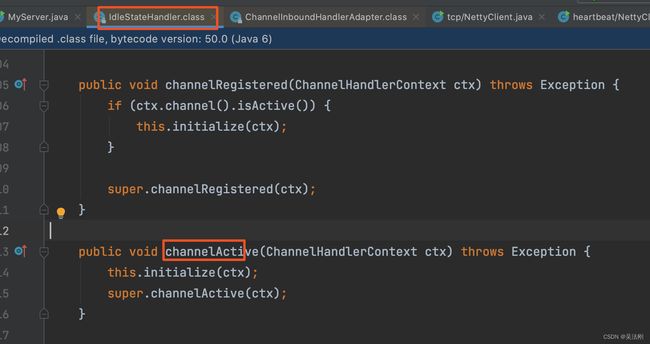netty基础_05.Netty 心跳检测机制案例
netty基础_05.Netty 心跳检测机制案例
-
- Netty 心跳检测机制案例
- 概述
-
- 心跳机制
- 心跳实现
- MyServer
- MyServerHandler
- 客户端
- IdleStateHandler源码分析
- 总结
Netty 心跳检测机制案例
实例要求:
- 编写一个
Netty心跳检测机制案例,当服务器超过3秒没有读时,就提示读空闲 - 当服务器超过
5秒没有写操作时,就提示写空闲 - 实现当服务器超过
7秒没有读或者写操作时,就提示读写空闲 - 代码如下:
IdleStateHandler 主要是用的IdleStateHandler实现
概述
心跳机制
心跳是在TCP长连接中,客户端和服务端定时向对方发送数据包通知对方自己还在线,保证连接的有效性的一种机制
在服务器和客户端之间一定时间内没有数据交互时, 即处于 idle 状态时, 客户端或服务器会发送一个特殊的数据包给对方, 当接收方收到这个数据报文后, 也立即发送一个特殊的数据报文, 回应发送方, 此即一个 PING-PONG 交互. 自然地, 当某一端收到心跳消息后, 就知道了对方仍然在线, 这就确保 TCP 连接的有效性.
心跳实现
使用TCP协议层的Keeplive机制,但是该机制默认的心跳时间是2小时,依赖操作系统实现不够灵活;
应用层实现自定义心跳机制,比如Netty实现心跳机制;
//加入一个netty 提供 IdleStateHandler
/*
说明
1. IdleStateHandler 是netty 提供的处理空闲状态的处理器
2. long readerIdleTime : 表示多长时间没有读, 就会发送一个心跳检测包检测是否连接
3. long writerIdleTime : 表示多长时间没有写, 就会发送一个心跳检测包检测是否连接
4. long allIdleTime : 表示多长时间没有读写, 就会发送一个心跳检测包检测是否连接
5. 文档说明
triggers an {@link IdleStateEvent} when a {@link Channel} has not performed
read, write, or both operation for a while.
6. 当 IdleStateEvent 触发后 , 就会传递给管道 的下一个handler去处理,通过调用(触发)
下一个handler 的 userEventTiggered , 在该方法中去处理 IdleStateEvent(读空闲,写空闲,读写空闲)
7.handlerRemoved有时候是无法感知连接断掉,所以还是需要心跳包的检测来判断连接是否还有效
*/
pipeline.addLast(new IdleStateHandler(3,5,7, TimeUnit.SECONDS));
//加入一个对空闲检测进一步处理的handler(自定义)
pipeline.addLast(new MyServerHandler());
我们只在服务端增加心跳检测机制,当然客户端也可以添加检测机制
MyServer
package com.netty.heartbeat;
import io.netty.bootstrap.ServerBootstrap;
import io.netty.channel.ChannelFuture;
import io.netty.channel.ChannelInitializer;
import io.netty.channel.ChannelPipeline;
import io.netty.channel.EventLoopGroup;
import io.netty.channel.nio.NioEventLoopGroup;
import io.netty.channel.socket.SocketChannel;
import io.netty.channel.socket.nio.NioServerSocketChannel;
import io.netty.handler.logging.LogLevel;
import io.netty.handler.logging.LoggingHandler;
import io.netty.handler.timeout.IdleStateHandler;
import java.util.concurrent.TimeUnit;
/**
* @author wufagang
* @description
* @date 2022年06月05日 09:03
*/
public class MyServer {
public static void main(String[] args) throws InterruptedException {
//创建两个线程组
EventLoopGroup bossGroup = new NioEventLoopGroup(1);
EventLoopGroup workerGroup = new NioEventLoopGroup(); //8个NioEventLoop
try {
ServerBootstrap serverBootstrap = new ServerBootstrap();
serverBootstrap.group(bossGroup, workerGroup);
serverBootstrap.channel(NioServerSocketChannel.class);
//在bossGroup增加一个日志处理器
serverBootstrap.handler(new LoggingHandler(LogLevel.INFO));
serverBootstrap.childHandler(new ChannelInitializer<SocketChannel>() {
@Override
protected void initChannel(SocketChannel ch) throws Exception {
System.out.println("--------");
ChannelPipeline pipeline = ch.pipeline();
//加入一个netty 提供 IdleStateHandler
/*
说明
1. IdleStateHandler 是netty 提供的处理空闲状态的处理器
2. long readerIdleTime : 表示多长时间没有读, 就会发送一个心跳检测包检测是否连接
3. long writerIdleTime : 表示多长时间没有写, 就会发送一个心跳检测包检测是否连接
4. long allIdleTime : 表示多长时间没有读写, 就会发送一个心跳检测包检测是否连接
5. 文档说明
triggers an {@link IdleStateEvent} when a {@link Channel} has not performed
read, write, or both operation for a while.
6. 当 IdleStateEvent 触发后 , 就会传递给管道 的下一个handler去处理,通过调用(触发)
下一个handler 的 userEventTiggered , 在该方法中去处理 IdleStateEvent(读空闲,写空闲,读写空闲)
7.handlerRemoved有时候是无法感知连接断掉,所以还是需要心跳包的检测来判断连接是否还有效
*/
pipeline.addLast(new IdleStateHandler(3,5,7, TimeUnit.SECONDS));
//加入一个对空闲检测进一步处理的handler(自定义)
pipeline.addLast(new MyServerHandler());
}
});
//启动服务器
ChannelFuture channelFuture = serverBootstrap.bind(9999).sync();
channelFuture.channel().closeFuture().sync();
}finally {
bossGroup.shutdownGracefully();
workerGroup.shutdownGracefully();
}
}
}
MyServerHandler
package com.netty.heartbeat;
import io.netty.channel.ChannelHandlerContext;
import io.netty.channel.ChannelInboundHandlerAdapter;
import io.netty.handler.timeout.IdleStateEvent;
/**
* @author wufagang
* @description
* @date 2022年06月05日 09:06
*/
public class MyServerHandler extends ChannelInboundHandlerAdapter {
@Override
public void userEventTriggered(ChannelHandlerContext ctx, Object evt) throws Exception {
System.out.println("=========");
if(evt instanceof IdleStateEvent) {
//将 evt 向下转型 IdleStateEvent
IdleStateEvent event = (IdleStateEvent) evt;
String eventType = null;
switch (event.state()) {
case READER_IDLE:
eventType = "读空闲";
break;
case WRITER_IDLE:
eventType = "写空闲";
break;
case ALL_IDLE:
eventType = "读写空闲";
break;
}
System.out.println(ctx.channel().remoteAddress() + "--超时时间--" + eventType);
System.out.println("服务器做相应处理..");
//如果发生空闲,我们关闭通道
// ctx.channel().close();
}
}
}
客户端
package com.netty.heartbeat;
import com.netty.tcp.NettyClientHandler;
import io.netty.bootstrap.Bootstrap;
import io.netty.channel.ChannelFuture;
import io.netty.channel.ChannelInitializer;
import io.netty.channel.EventLoopGroup;
import io.netty.channel.nio.NioEventLoopGroup;
import io.netty.channel.socket.SocketChannel;
import io.netty.channel.socket.nio.NioSocketChannel;
/**
* @author wufagang
* @description
* @date 2022年06月04日 11:24
*/
public class NettyClient {
public static void main(String[] args) {
//客户端需要一个事件循环组
EventLoopGroup group = new NioEventLoopGroup();
try {
//创建客户端启动对象
//注意客户端使用的不是 ServerBootstrap 而是 Bootstrap
Bootstrap bootstrap = new Bootstrap();
//设置相关参数
bootstrap.group(group) //设置线程组
.channel(NioSocketChannel.class) // 设置客户端通道的实现类(反射)
.handler(new ChannelInitializer<SocketChannel>() {
@Override
protected void initChannel(SocketChannel ch) throws Exception {
ch.pipeline().addLast(new NettyClientHandler()); //加入自己的处理器
}
});
System.out.println("客户端 ok..");
//启动客户端去连接服务器端
//关于 ChannelFuture 要分析,涉及到netty的异步模型
ChannelFuture channelFuture = bootstrap.connect("127.0.0.1", 9999).sync();
//对关闭通道事件 进行监听
channelFuture.channel().closeFuture().sync();
} catch (InterruptedException e) {
e.printStackTrace();
} finally {
group.shutdownGracefully();
}
}
}
效果
=========
/127.0.0.1:51070--超时时间--读空闲
服务器做相应处理..
=========
/127.0.0.1:51070--超时时间--写空闲
服务器做相应处理..
=========
/127.0.0.1:51070--超时时间--读空闲
服务器做相应处理..
=========
/127.0.0.1:51070--超时时间--读写空闲
IdleStateHandler源码分析
IdleStateHandler构造器
-
readerIdleTime读空闲超时时间设定,如果channelRead()方法超过readerIdleTime时间未被调用则会触发超时事件调用userEventTrigger()方法;
-
writerIdleTime写空闲超时时间设定,如果write()方法超过writerIdleTime时间未被调用则会触发超时事件调用userEventTrigger()方法;
-
allIdleTime所有类型的空闲超时时间设定,包括读空闲和写空闲;
-
unit时间单位,包括时分秒等;
心跳检测也是一种Handler,在启动时添加到ChannelPipeline管道中,当有读写操作时消息在其中传递;
socketChannel.pipeline().addLast(new IdleStateHandler(5, 0, 0, TimeUnit.SECONDS));
IdleStateHandler的channelActive()方法在socket通道建立时被触发

channelActive()方法调用Initialize()方法,根据配置的readerIdleTime,WriteIdleTIme等超时事件参数往任务队列taskQueue中添加定时任务task ;
private void initialize(ChannelHandlerContext ctx) {
switch(this.state) {
case 1:
case 2:
return;
default:
this.state = 1;
this.initOutputChanged(ctx);
this.lastReadTime = this.lastWriteTime = this.ticksInNanos();
if (this.readerIdleTimeNanos > 0L) {
this.readerIdleTimeout = this.schedule(ctx, new IdleStateHandler.ReaderIdleTimeoutTask(ctx), this.readerIdleTimeNanos, TimeUnit.NANOSECONDS);
}
if (this.writerIdleTimeNanos > 0L) {
this.writerIdleTimeout = this.schedule(ctx, new IdleStateHandler.WriterIdleTimeoutTask(ctx), this.writerIdleTimeNanos, TimeUnit.NANOSECONDS);
}
if (this.allIdleTimeNanos > 0L) {
this.allIdleTimeout = this.schedule(ctx, new IdleStateHandler.AllIdleTimeoutTask(ctx), this.allIdleTimeNanos, TimeUnit.NANOSECONDS);
}
}
}
定时任务添加到对应线程EventLoopExecutor对应的任务队列taskQueue中,在对应线程的run()方法中循环执行
-
用当前时间减去最后一次channelRead方法调用的时间判断是否空闲超时;
-
如果空闲超时则创建空闲超时事件并传递到channelPipeline中;
new IdleStateHandler.ReaderIdleTimeoutTask(ctx)
new IdleStateHandler.WriterIdleTimeoutTask(ctx)
new IdleStateHandler.AllIdleTimeoutTask(ctx)
private final class ReaderIdleTimeoutTask extends IdleStateHandler.AbstractIdleTask {
ReaderIdleTimeoutTask(ChannelHandlerContext ctx) {
super(ctx);
}
protected void run(ChannelHandlerContext ctx) {
long nextDelay = IdleStateHandler.this.readerIdleTimeNanos;
if (!IdleStateHandler.this.reading) {
nextDelay -= IdleStateHandler.this.ticksInNanos() - IdleStateHandler.this.lastReadTime;
}
if (nextDelay <= 0L) {
IdleStateHandler.this.readerIdleTimeout = IdleStateHandler.this.schedule(ctx, this, IdleStateHandler.this.readerIdleTimeNanos, TimeUnit.NANOSECONDS);
boolean first = IdleStateHandler.this.firstReaderIdleEvent;
IdleStateHandler.this.firstReaderIdleEvent = false;
try {
IdleStateEvent event = IdleStateHandler.this.newIdleStateEvent(IdleState.READER_IDLE, first);
IdleStateHandler.this.channelIdle(ctx, event);
} catch (Throwable var6) {
ctx.fireExceptionCaught(var6);
}
} else {
IdleStateHandler.this.readerIdleTimeout = IdleStateHandler.this.schedule(ctx, this, nextDelay, TimeUnit.NANOSECONDS);
}
}
}
总结
-
IdleStateHandler心跳检测主要是通过向线程任务队列中添加定时任务,判断channelRead()方法或write()方法是否调用空闲超时,如果超时则触发超时事件执行自定义userEventTrigger()方法;
-
Netty通过IdleStateHandler实现最常见的心跳机制不是一种双向心跳的PING-PONG模式,而是客户端发送心跳数据包,服务端接收心跳但不回复,因为如果服务端同时有上千个连接,心跳的回复需要消耗大量网络资源;如果服务端一段时间内内有收到客户端的心跳数据包则认为客户端已经下线,将通道关闭避免资源的浪费;在这种心跳模式下服务端可以感知客户端的存活情况,无论是宕机的正常下线还是网络问题的非正常下线,服务端都能感知到,而客户端不能感知到服务端的非正常下线;
-
要想实现客户端感知服务端的存活情况,需要进行双向的心跳;Netty中的channelInactive()方法是通过Socket连接关闭时挥手数据包触发的,因此可以通过channelInactive()方法感知正常的下线情况,但是因为网络异常等非正常下线则无法感知;